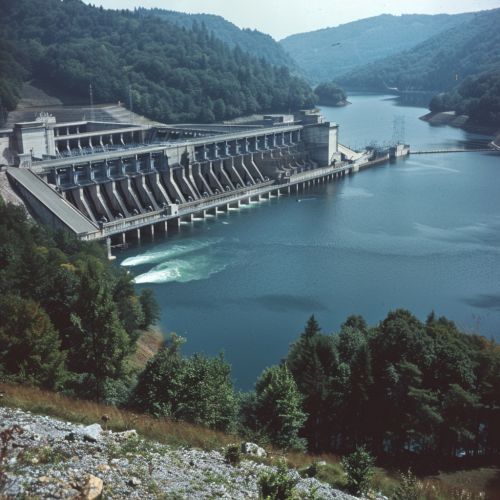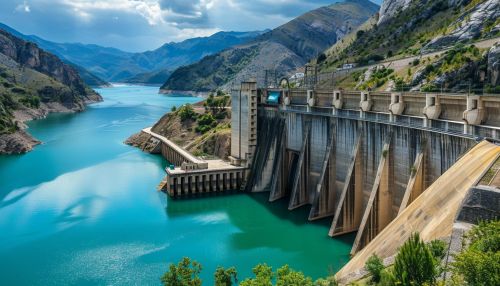Hydropower
Introduction
Hydropower, or hydroelectric power, is a form of renewable energy that harnesses the power of water to generate electricity. It is currently the largest source of renewable energy, contributing about 16% of global electricity production. This article delves into the principles of hydropower, its history, types, advantages, disadvantages, and its role in the future of energy production.
Principles of Hydropower
Hydropower works by converting the kinetic energy of flowing or falling water into mechanical energy, which is then converted into electrical energy. This process involves a series of steps, starting with the collection of water in a reservoir created by a dam. The potential energy stored in the water is released when it is allowed to flow down a pipe called a penstock, which leads to a turbine. The force of the water turns the turbine, which is connected to a generator. The generator then converts the mechanical energy into electrical energy, which is transmitted to homes and businesses through power lines.


History of Hydropower
The use of water for power dates back thousands of years to the ancient Greeks, who used water wheels to grind wheat into flour. The modern era of hydropower began in the late 19th century with the development of the first hydroelectric power plant in Appleton, Wisconsin, USA. Since then, the technology has evolved and expanded, with large-scale hydroelectric dams now providing a significant portion of the world's electricity.
Types of Hydropower Systems
There are several types of hydropower systems, each with its own unique characteristics and uses. These include:
- Impoundment Hydropower: This is the most common type of hydropower system and involves the creation of a reservoir by building a dam across a river. The water in the reservoir is released to flow through a turbine, generating electricity.
- Diversion or Run-of-River Hydropower: In this system, a portion of a river's water is diverted through a canal or penstock to flow through a turbine. This type of system does not require a large reservoir, making it less environmentally impactful.
- Pumped Storage Hydropower: This system works like a battery, storing energy for use when demand is high. During periods of low electricity demand, excess electricity is used to pump water from a lower reservoir to an upper reservoir. When demand is high, the stored water is released to flow through a turbine, generating electricity.
- Tidal Hydropower: This type of system harnesses the energy of ocean tides to generate electricity. Tidal power is still in its early stages of development but holds great potential for future energy production.
Advantages of Hydropower
Hydropower offers several advantages over other forms of energy production. These include:
- Renewability: As long as the water cycle continues, there will be a source of energy for hydropower. This makes it a sustainable and renewable source of energy.
- Low Emissions: Hydropower produces very low emissions, making it a clean source of energy that contributes to the reduction of greenhouse gases.
- Reliability and Flexibility: Hydropower plants can quickly adjust to changes in electricity demand, making them a reliable and flexible source of energy.
- Economic Benefits: The construction and operation of hydropower plants create jobs and contribute to local economies. Additionally, the electricity produced is often cheaper than that from fossil fuels.
Disadvantages of Hydropower
Despite its advantages, hydropower also has several disadvantages. These include:
- Environmental Impact: The construction of dams and reservoirs can have significant environmental impacts, including habitat destruction, changes to water quality and flow, and the displacement of local communities.
- High Initial Costs: The construction of hydropower plants, particularly large-scale dams, can be expensive. However, once operational, the costs of running and maintaining the plants are relatively low.
- Dependence on Water Availability: The effectiveness of hydropower is dependent on the availability of water. In areas with seasonal or irregular rainfall, this can affect the reliability of hydropower.
The Future of Hydropower
While hydropower already plays a significant role in global energy production, its future looks promising. With advancements in technology and an increased focus on renewable energy, the potential for hydropower to contribute to a sustainable energy future is significant. However, careful planning and management are required to mitigate the environmental impacts and ensure the long-term sustainability of this valuable resource.
